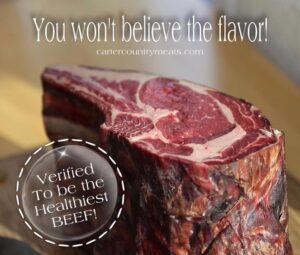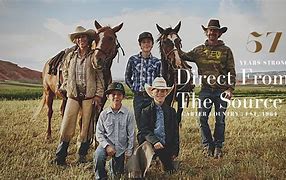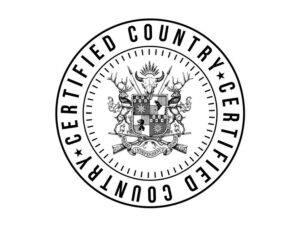The Big Horn Mountains of Wyoming stretch across the western fields of grass. Cows are looking for their next meal by living off the land by open-grazing on 40,000 acres. So that is the tagline I came up with, even though it is a little corny. So, I was sitting down for our call Tuesday night, and this rancher came on to sell meat. Not just any kind of meat, but free-roaming cows across his 40,000 acres. They have a large ranch in the northwestern part of Wyoming; they mean his wife and three boys. Furthermore, he has started to build his legacy by supplying the country with nutrient-rich meats. From his ranch on the western side of the Big Horn Mountains of Wyoming.
Ranching in the Big Horn Mountains of Wyoming:
This is a grass-fed beef company that raises and sells premium cuts of beef around the country. Their beef is raised on a ranch that is a 40,000-acre property in the city of Ten Sleep, Wyoming. The ranch is located on the western edge of the Big Horn Mountains and has 27 natural springs on it. Ranching in the Big Horn Mountains of Wyoming is glorious, but it is hard work.
90+ Years on this Corporate System has to Change:
This type of ranching left the US in the 1930s and was replaced with what we have today. It goes like this, and you can see why it became so unhealthy. Have you ever heard the expression, You are what you eat! That is true of us, but it is true of our food source as well. When we treat our food source (cows) the corporate way and don’t feed them well, it’s just enough to pass the USDA and get our beef to market. We have to do better, and we believe we have found the family to do just that!
The biggest misconception about big ranchers is that they are rich. They are rich in land, but they are cash poor because corporations hire them to raise cows. Who keeps all the profits? The corporation has been on top of this dynamic called Corporate Agriculture for 90+ years.
Corporate Agriculture:
- Rancher: To maintain their herd or to produce offspring for sale, cows and bulls must be bred. By giving their livestock a balanced diet to ensure they get enough nourishment for growth and development. This includes feeding hay and/or silage, as well as grazing on pasture. Ranchers keep an eye on the wellbeing of their animals, provide vaccines, and take precautions against parasites and illnesses. They also maintain pastures to make sure their cattle have a sufficient source of nutrient-rich fodder.
- Stocker: Describes a management strategy for bringing young, light calves to market weight or adding pounds to supply cows and bulls.
- Feedlot: The last stage of cattle production is a feedlot. It is a restricted area where steers and heifers are fed a ration of grain, silage, hay, and/or protein supplement in order to produce a meat product that meets the USDA quality grade Select or higher for the butchering market.
- Processor/Slaughter Market: They will slaughter the animals and process the meat into various cuts and products to be shipped to market.
- Wholesaler: Must ensure that the cattle are of good quality and satisfy the requirements that have been set by retailers or processors. They also guarantee that the meat products are delivered to their destination in a safe manner.
- Supermarket: Then the beef is prepared, packed, and put up for sale to consumers at the meat department at the Supermarket.
- Finally, You: The consumer, buy the meat of your choice and get an inferior product. Further, it has been mass-produced with water and beef that has been raised in a controlled environment.
So, this seems to be a very unhealthy way to go on like it is. But how are we going to change it? With the help of people like the Carters, we can start changing everyone’s minds, one person at a time.
The Big Horn Mountains of Wyoming Way:
- Rancher: Cows and bulls must be bred to produce offspring to maintain their herd. They are not taken for their beef until they are between the ages of 4 and 14 years of age. By giving their livestock a balanced diet to ensure they get enough nourishment for growth and development. This includes open grazing on nutrient-rich plant life that has come back to the ranch. They keep an eye on the wellbeing of their animals, provide vaccines, and take precautions against parasites and illnesses.
- Processor: They will slaughter the animal and package up the beef into packs depending on the order size.
- You/Consumer: They will ship it right to your doorstep for your delicious taste buds. You eat this burger and any steak, and you’ll be amazed at the flavor. You will wonder what you’ve been eating all these years.
This family offers ordering by individual steak, hamburger, or any of the delicious options available. You can also order a variety of sizes and cuts of beef.
Their Big Horn Boxes in:
- 6 lbs. Mixed Cuts plus Ground
- 8 lbs. Ground Beef
- 10 lbs. Mixed Cuts plus Ground
- 20 lbs. Mixed Cuts plus Ground
- 28 LBS Ground Beef

Their Premium Individual Cuts Include:
- Dry-aged grass-fed ground beef
- Summer Sausage
- 45-Day Dry-Aged NY Strip Steak
- 45-Day Dry-Aged Ribeye Tomahawk
- Tenderloin Full Muscle
- Broth Flavored with Beef Bones
__________________________________________________
Don’t forget their Beef Blended Dog Food A wonderful mix of 10% heart, 15% liver, 20% fat, and 55% lean beef. Our dog chow is created entirely from grass-fed beef because we firmly believe in the healing potential of natural ingredients. Grass-fed beef is superior to regular beef in that it is full of healthy nutrients and devoid of harmful additives. So include it in your next round of Beef.
_________________________________________________________
Big Horn Mountains of Wyoming and the Science:
This family has been in business since 1964, and they are proud of their accomplishments. The Bio-Nutritional Food Association classified their meats as 64% richer in phytonutrients. In other words, antioxidants, according to a recent nutrient density assessment. The fatty acid profile of grass-fed beef differs from that of grain-fed cattle. The nutrients in beef might vary based on the diet of the cows. Many countries, including Australia, consume grass-fed beef. It’s worth noting that grass-fed beef is frequently a healthier option than grain-fed beef since it contains more phytonutrients that promote health, such as terpenoids, phenols, carotenoids, and antioxidants.
In other words, corporate stature has destroyed the delicate ecosystem that was going on. To have the right ecosystem, the cows will range over the land, eating as they range. However, they will not go back to the same spot until around a year later. By then, plant life would grow back with the nutrients the cows needed from a variety of species of plants.
The plants will also grow back with the increased nutrients that the cows need from their manure. The manure acts as an information piece, telling the plant what is missing in the cow. It all works as an ecosystem that is dependent on the cow not returning until the plant has time to grow back. Pretty cool system, if you ask me.
Fine Wine and Steak:
The Big Horn Mountains in Wyoming offer a beautiful backdrop for enjoying Fine Wine and Steak, but it’s important to note that this region is not particularly known for its wine production. Wyoming is not a major wine-producing state, and the climate and geography of the Big Horn Mountains are more conducive to other outdoor activities like hiking, camping, and raising cattle.
Nevertheless, by bringing your own wine, you may still have a delicious dinner and an amazing wine amid the Wyoming Mountains. Here’s a suggestion for an excellent supper.
You can decide between ribeye or tenderloin cuts of steak, as Wyoming is recognized for its excellent meats. To go with your steaks, think about a robust red wine like a Cabernet Sauvignon or a Ricord Merlot. A Chardonnay or a Sauvignon Blanc might also be fantastic if you favor white wine.
—–###—–



